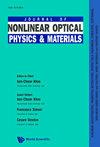化学剥离的β-Bi2O3纳米片
IF 2.3
4区 物理与天体物理
Q2 OPTICS
引用次数: 0
摘要
探索二维材料对于量子材料领域的进一步发展具有重要意义。然而,二维材料开发的进展受到其生产困难的限制。具体来说,具有块状非层状结构的独立2D材料的制备仍然特别具有挑战性。传统上,化学或机械剥离用于获得独立的2D材料,但这些方法通常需要分层的起始材料。本文提出了用化学剥离法制备具有三维共价结构的β-Bi2O3薄层的方法。在本研究中,用酸和水剥离Na3Ni2BiO6,得到高度小于10 nm,横向尺寸大于1 μ m的β-Bi2O3纳米片。我们的研究结果为进一步探索β-Bi2O3纳米片提供了可能性,以确定它们的性质是否会从体到纳米尺度发生变化。此外,本研究将促进利用化学剥离法制备非层状体材料纳米片的进一步发展。本文章由计算机程序翻译,如有差异,请以英文原文为准。
Chemically exfoliated nanosheets of β-Bi2O3
Exploring two dimensional (2D) materials is important for further developing the field of quantum materials. However, progress in 2D material development is limited by difficulties with their production. Specifically, freestanding 2D materials with bulk non-layered structures remain particularly challenging to prepare. Traditionally, chemical or mechanical exfoliation is employed for obtaining freestanding 2D materials, but these methods typically require layered starting materials. Here we put forth a method for obtaining thin layers of β-Bi2O3, which has a three-dimensional covalent structure, by using chemical exfoliation. In this research, Na3Ni2BiO6 was exfoliated with acid and water to obtain β-Bi2O3 nanosheets less than 10 nm in height and over 1 µm in lateral size. Our results open the possibility for further exploring β-Bi2O3 nanosheets to determine whether their properties change from the bulk to the nanoscale. Furthermore, this research may facilitate further progress in obtaining nanosheets of non-layered bulk materials using chemical exfoliation.
求助全文
通过发布文献求助,成功后即可免费获取论文全文。
去求助
来源期刊
CiteScore
3.00
自引率
48.10%
发文量
53
审稿时长
3 months
期刊介绍:
This journal is devoted to the rapidly advancing research and development in the field of nonlinear interactions of light with matter. Topics of interest include, but are not limited to, nonlinear optical materials, metamaterials and plasmonics, nano-photonic structures, stimulated scatterings, harmonic generations, wave mixing, real time holography, guided waves and solitons, bistabilities, instabilities and nonlinear dynamics, and their applications in laser and coherent lightwave amplification, guiding, switching, modulation, communication and information processing. Original papers, comprehensive reviews and rapid communications reporting original theories and observations are sought for in these and related areas. This journal will also publish proceedings of important international meetings and workshops. It is intended for graduate students, scientists and researchers in academic, industrial and government research institutions.

 求助内容:
求助内容: 应助结果提醒方式:
应助结果提醒方式:


